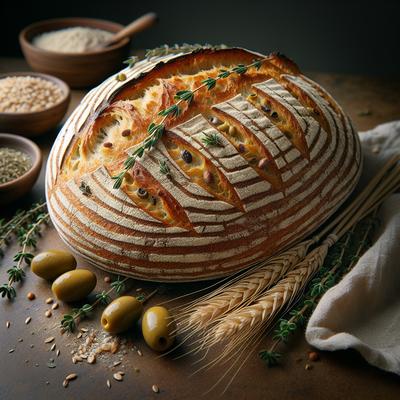Olive & Thyme Sourdough
Elevate your bread-baking game with this artisanal Olive & Thyme Sourdough, a flavorful twist on the classic sourdough recipe. Infused with briny black olives and aromatic fresh thyme, this bread offers a perfect balance of savory and earthy notes. Crafted with a slow fermentation process for incredible depth of flavor and a chewy, airy crumb, this recipe is ideal for seasoned bakers looking for a rewarding culinary project. With a crisp, golden crust and a rustic yet elegant appearance, this sourdough loaf makes a stunning addition to dinner spreads, charcuterie boards, or even a simple slice slathered with butter. Whether you're mastering stretch-and-fold techniques or savoring the irresistible aroma wafting from the oven, this bread is sure to impress both your senses and your guests.
Try SnapCalorie's FREE AI assisted nutrition tracking free in the App store or on Android.

Ingredients
- 100 grams Active sourdough starter
- 350 grams Filtered water
- 500 grams Bread flour
- 9 grams Salt
- 100 grams Pitted black olives
- 10 grams Fresh thyme leaves
Directions
Step 1
In a large mixing bowl, dissolve the active sourdough starter in 350 grams of filtered water until well mixed.
Step 2
Add in 500 grams of bread flour and mix until no dry flour remains. Cover the bowl with a damp cloth and allow the dough to rest for 30 minutes for autolyse.
Step 3
After resting, add 9 grams of salt to the dough and use a pinch and fold technique to incorporate it. Perform this step with wet hands to prevent sticking.
Step 4
For the next 2 hours, perform a series of stretch and folds every 30 minutes. To do this, grab the dough from one side, stretch it up, and fold it over itself. Rotate the bowl and repeat from the other three sides.
Step 5
After the first 2 hours and the stretch and fold process, gently incorporate 100 grams of roughly chopped pitted black olives and 10 grams of fresh thyme leaves into the dough during the next folding session.
Step 6
Allow the dough to continue to proof at room temperature until it has risen by about 50%. This can take between 2 to 4 hours depending on room temperature.
Step 7
Transfer the dough onto a lightly floured surface and shape it into a round by folding the edges toward the center. Let it rest for 20 minutes, covered with a towel.
Step 8
Final shape the rested dough into a tight ball and place it seam side up in a floured banneton or proofing basket.
Step 9
Cover the basket with a damp cloth or plastic wrap and refrigerate for at least 12 hours or overnight for a cold retardation process.
Step 10
Preheat your oven to 250°C (482°F) with a Dutch oven inside. Once preheated, carefully remove the hot Dutch oven and place a piece of parchment paper over the banneton, then invert it to release the dough.
Step 11
Score the top of the dough with a sharp blade to allow it to expand during baking.
Step 12
Carefully place the dough along with the parchment paper into the hot Dutch oven, cover it, and bake for 20 minutes.
Step 13
After 20 minutes, reduce the oven temperature to 230°C (446°F), remove the lid, and bake for an additional 25 minutes or until the crust is deep golden brown.
Step 14
Allow the bread to cool completely on a wire rack before slicing and serving.
Nutrition Facts
| Serving size | 1069 grams (1069.0g) |
|---|
| Amount per serving | % Daily Value* |
|---|---|
| Calories | 2053 |
| Total Fat 25.30g | 32% |
| Saturated Fat 5.60g | 28% |
| Cholesterol 0mg | 0% |
| Sodium 4836mg | 210% |
| Total Carbohydrate 398.70g | 145% |
| Dietary Fiber 18.80g | 67% |
| Total Sugars 1.50g | |
| Protein 61.00g | 122% |
| Vitamin D 0IU | 0% |
| Calcium 123mg | 9% |
| Iron 64mg | 353% |
| Potassium 557mg | 12% |
Source of Calories
